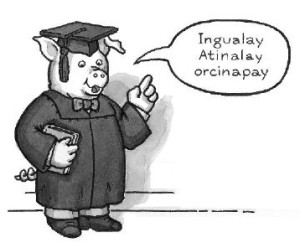The Origins of Pig Latin

Did you learn Pig Latin as a child? If so, like many Americans, Pig Latin might have been the first “second language” you learned! Somewhere between second and sixth grade, a child is asked, “Ooday ouyay peaksay igpay atinlay?” At which point, the exciting process of orienting the ear to understand it more quickly, and processing language patterns to be able to speak it more fluently, becomes an obsession. But what exactly are the origins of Pig Latin? Where did it come from and why does it continue to be such a social milestone of sorts for the American child?
Versions of Pig Latin have existed since Shakespeare
No, seriously, they have. Some history buffs believe forms of Pig Latin, also referred to as “dog Latin” may have gotten their start in word games played by monks to play with real Latin. Hence, the term Dog or Pig Latin was a reference to the fact that it was a corrupted version of that ancient tongue, with consistent patterns, making it distinguishable in its own right. It was used to create fun plays on words, corrupting well-known or memorized poetry verses, or philosophical turns of phrase.
In The Straight Dope blog, author Sam Clem gives an example straight out of Shakespeare, where a character uses an example of this Latin word play.
Love’s Labor Lost (act v, scene 1):
Costard: Go to; thou hast it ad dungill, at the fingers’ ends, as they say.
Holofernes: O, I smell false Latine; dunghill for unguem.
Although the false Latine Holofernes refers to is not the Pig Latin we know today, it demonstrates this type of word play has existed for hundreds of years.
There is more than one way to speak Pig Latin
There have been multiple versions of Pig Latin through the ages. The version most of us know and love today removes the first letter from each word, tacks it to the end of the word, and adds an “ay”. Hence, the word language, becomes anguagelay. There are variations of the rules when it comes to letters that begin with a vowel, or for single syllable words.
We know Pig Latin has been spoken in other forms because they’re referenced in literature. For example, The Straight Dope provides additional literary references to Pig Latin. Edgar Allen Poe spoke of “pig Greek” in his writing in 1844, and one of Walter Scott’s characters in Kennilworth says, “A very learned man … and can vent Greek and Hebrew as fast as I can ‘thieves’ Latin.”
An example of an alternate version of Pig Latin is from a 19th century magazine called The Galaxy:
A boy asking a friend to go with him says, “Wig-ge you-ge go-ge wig-ge me-ge?”
The other, replying in the negative says, “Noge, Ige woge.”
You can see how this version simply tacked the syllable “ge” on to the end of words, with some rules about various constant finishes.
According to the Grammar Girl website, Pig Latin celebrated its heyday back in the 1920s and 30s. In fact, we even use two words in their Pig Latin form today, ixnay and amscray, which are a part of the vernacular for people who may not even realize their origin is rooted in Pig Latin.
Americans aren’t the only ones who love Pig Latin
It seems like wherever there are lovers of language, there are individuals who will play around to create Pig Latin-esque versions of it. There are similar word play games all over the world, including Loucherbem in France, Varkens Latijn in Denmark, and Mattenenglisch in Germany.
So go ahead and celebrate your love of language by speaking some Pig Latin today. Oodgay ucklay!






